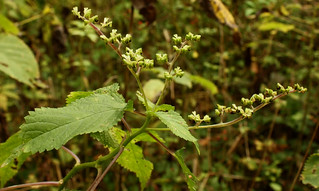It's not a particularly eye-catching plant. The blossoms are small and dull green.

(Click on images to enlarge)
If you look beneath the leaves at its stems, you will find them covered with short spines.

If I understand the matter correctly, it is not these spines that do the stinging, but tiny, almost invisible-to-the-naked-eye hairs. From Wikipedia:
The plant has many hollow stinging hairs called trichomes on its leaves and stems, which act like hypodermic needles that inject histamine and other chemicals that produce a stinging sensation when contacted by humans and other animals.I had never identified stinging nettle and never noticed it in the park before, but then I'd never walked down that particular path in late summer before. I always wear long sleeves in the woods, so only my hands were exposed. We hadn't gotten far down that path before I started wondering how those wasps could keep stinging my hands without my seeing them. It was a while before the idea of stinging nettled occurred to me. Then out came Newcomb's Wildflower Guide and, "Oh! So that's stinging nettle!"
In my case the stinging lasted only a minute or so. I understand that in more sensitive people it can last for days.


No comments:
Post a Comment